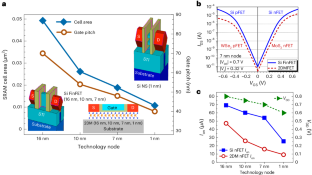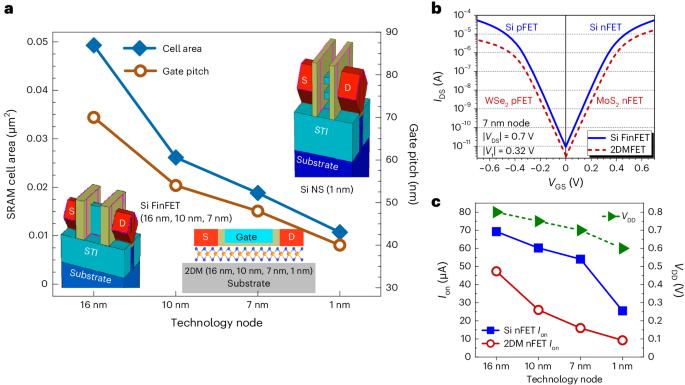Projected performance of Si- and 2D-material-based SRAM circuits ranging from 16 nm to 1 nm technology nodes
IF 38.1
1区 材料科学
Q1 MATERIALS SCIENCE, MULTIDISCIPLINARY
引用次数: 0
Abstract
Researchers have been developing 2D materials (2DM) for electronics, which are widely considered a possible replacement for silicon in future technology. Two-dimensional transition metal dichalcogenides are the most promising among the different materials due to their electronic performance and relatively advanced development. Although field-effect transistors (FETs) based on 2D transition metal dichalcogenides have been found to outperform Si in ultrascaled devices, the comparison of 2DM-based and Si-based technologies at the circuit level is still missing. Here we compare 2DM- and Si FET-based static random-access memory (SRAM) circuits across various technology nodes from 16 nm to 1 nm and reveal that the 2DM-based SRAM exhibits superior performance in terms of stability, operating speed and energy efficiency when compared with Si SRAM. This study utilized technology computer-aided design to conduct device and circuit simulations, employing calibrated MoS2 nFETs and WSe2 pFETs. It incorporated layout design rules across various technology nodes to comprehensively analyse their SRAM functionality. The results show that, compared with three-dimensional structure Si transistors at 1 nm node, the planar 2DMFETs exhibited lower capacitance, leading to reduced cell read access time (−16%), reduced time to write (−72%) and lowered dynamic power (−60%). The study highlights the provisional benefits of using planar 2DM transistors to mitigate the performance degradation caused by reduced metal pitch and increased wire resistance in advanced nodes, potentially opening up exciting possibilities for high-performance and low-power circuit applications. Simulations show that two-dimensional-material-based static random-access memory (SRAM) circuits leverage their low parasitic capacitance, counteracting performance declines due to increased interconnect resistance and potentially surpassing Si-based SRAM in terms of both performance and energy efficiency at advanced technology nodes.


基于硅和二维材料的 SRAM 电路的预计性能,技术节点从 16 纳米到 1 纳米不等
研究人员一直在开发二维电子材料(2DM),这些材料被广泛认为是未来技术中硅的可能替代品。在各种材料中,二维过渡金属二钙化物因其电子性能和相对先进的发展水平而最有前途。尽管基于二维过渡金属二钴化物的场效应晶体管(FET)在超大规模器件中的性能已超过硅,但基于二维过渡金属二钴化物的技术和基于硅的技术在电路层面上的比较仍然缺失。在此,我们对基于 2DM 和硅场效应晶体管的静态随机存取存储器(SRAM)电路进行了比较,发现从 16 纳米到 1 纳米的不同技术节点中,基于 2DM 的 SRAM 在稳定性、运行速度和能效方面均优于硅 SRAM。这项研究利用技术计算机辅助设计,采用校准的 MoS2 nFET 和 WSe2 pFET 进行器件和电路仿真。研究结合了各种技术节点的布局设计规则,全面分析了它们的 SRAM 功能。结果表明,与 1 nm 节点的三维结构硅晶体管相比,平面 2DMFET 显示出更低的电容,从而缩短了单元读取访问时间(-16%),缩短了写入时间(-72%),降低了动态功率(-60%)。这项研究强调了使用平面 2DM 晶体管来缓解先进节点中因金属间距减小和导线电阻增加而导致的性能下降的暂时优势,为高性能和低功耗电路应用开辟了令人兴奋的可能性。
本文章由计算机程序翻译,如有差异,请以英文原文为准。
求助全文
约1分钟内获得全文
求助全文
来源期刊

Nature nanotechnology
工程技术-材料科学:综合
CiteScore
59.70
自引率
0.80%
发文量
196
审稿时长
4-8 weeks
期刊介绍:
Nature Nanotechnology is a prestigious journal that publishes high-quality papers in various areas of nanoscience and nanotechnology. The journal focuses on the design, characterization, and production of structures, devices, and systems that manipulate and control materials at atomic, molecular, and macromolecular scales. It encompasses both bottom-up and top-down approaches, as well as their combinations.
Furthermore, Nature Nanotechnology fosters the exchange of ideas among researchers from diverse disciplines such as chemistry, physics, material science, biomedical research, engineering, and more. It promotes collaboration at the forefront of this multidisciplinary field. The journal covers a wide range of topics, from fundamental research in physics, chemistry, and biology, including computational work and simulations, to the development of innovative devices and technologies for various industrial sectors such as information technology, medicine, manufacturing, high-performance materials, energy, and environmental technologies. It includes coverage of organic, inorganic, and hybrid materials.
 求助内容:
求助内容: 应助结果提醒方式:
应助结果提醒方式:


